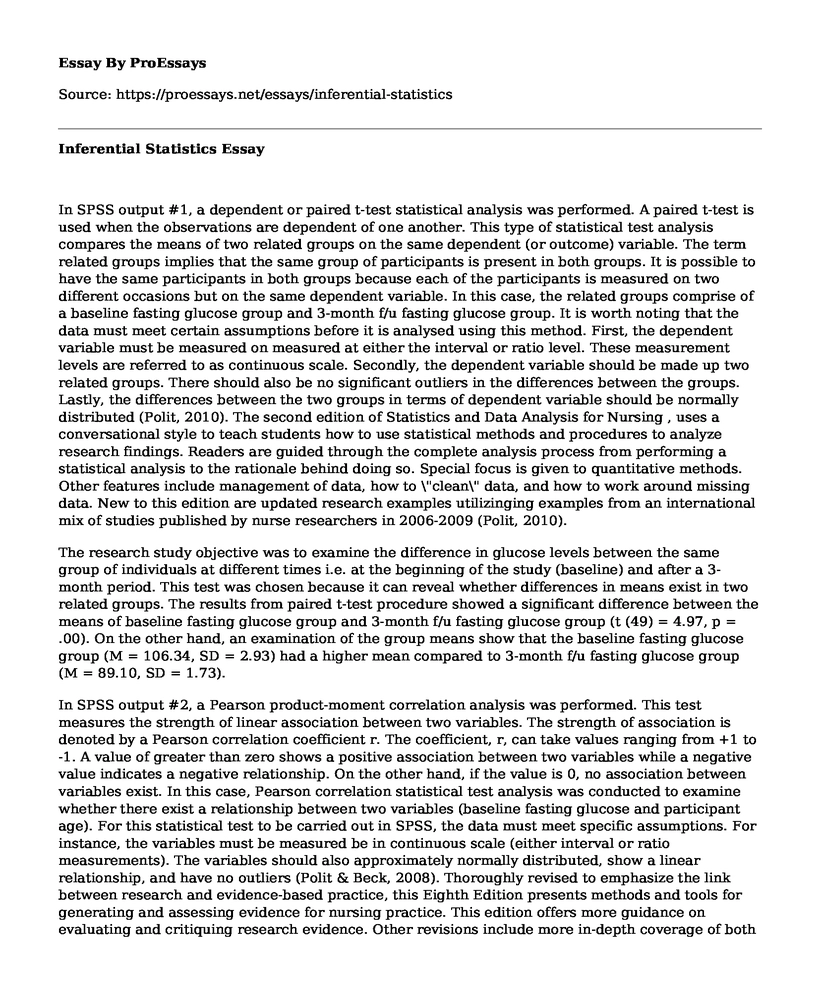In SPSS output #1, a dependent or paired t-test statistical analysis was performed. A paired t-test is used when the observations are dependent of one another. This type of statistical test analysis compares the means of two related groups on the same dependent (or outcome) variable. The term related groups implies that the same group of participants is present in both groups. It is possible to have the same participants in both groups because each of the participants is measured on two different occasions but on the same dependent variable. In this case, the related groups comprise of a baseline fasting glucose group and 3-month f/u fasting glucose group. It is worth noting that the data must meet certain assumptions before it is analysed using this method. First, the dependent variable must be measured on measured at either the interval or ratio level. These measurement levels are referred to as continuous scale. Secondly, the dependent variable should be made up two related groups. There should also be no significant outliers in the differences between the groups. Lastly, the differences between the two groups in terms of dependent variable should be normally distributed (Polit, 2010). The second edition of Statistics and Data Analysis for Nursing , uses a conversational style to teach students how to use statistical methods and procedures to analyze research findings. Readers are guided through the complete analysis process from performing a statistical analysis to the rationale behind doing so. Special focus is given to quantitative methods. Other features include management of data, how to \"clean\" data, and how to work around missing data. New to this edition are updated research examples utilizinging examples from an international mix of studies published by nurse researchers in 2006-2009 (Polit, 2010).
The research study objective was to examine the difference in glucose levels between the same group of individuals at different times i.e. at the beginning of the study (baseline) and after a 3-month period. This test was chosen because it can reveal whether differences in means exist in two related groups. The results from paired t-test procedure showed a significant difference between the means of baseline fasting glucose group and 3-month f/u fasting glucose group (t (49) = 4.97, p = .00). On the other hand, an examination of the group means show that the baseline fasting glucose group (M = 106.34, SD = 2.93) had a higher mean compared to 3-month f/u fasting glucose group (M = 89.10, SD = 1.73).
In SPSS output #2, a Pearson product-moment correlation analysis was performed. This test measures the strength of linear association between two variables. The strength of association is denoted by a Pearson correlation coefficient r. The coefficient, r, can take values ranging from +1 to -1. A value of greater than zero shows a positive association between two variables while a negative value indicates a negative relationship. On the other hand, if the value is 0, no association between variables exist. In this case, Pearson correlation statistical test analysis was conducted to examine whether there exist a relationship between two variables (baseline fasting glucose and participant age). For this statistical test to be carried out in SPSS, the data must meet specific assumptions. For instance, the variables must be measured be in continuous scale (either interval or ratio measurements). The variables should also approximately normally distributed, show a linear relationship, and have no outliers (Polit & Beck, 2008). Thoroughly revised to emphasize the link between research and evidence-based practice, this Eighth Edition presents methods and tools for generating and assessing evidence for nursing practice. This edition offers more guidance on evaluating and critiquing research evidence. Other revisions include more in-depth coverage of both qualitative and quantitative research and a new chapter on developing and testing new instruments. Note: The for-sale Student Resource guide to accompany the text is now fully revised to meet emerging graduate course needs. New features include a free CD-ROM called the \"Toolkit,\" which includes copious application exercises, samples of systematic reviews, and full critiques of two of the eight studies in the text. Please note that this is sold separately: Student Resource Manual with Toolkit, ISBN: 978-0-7817-7052-1 (Polit & Beck, 2012).
The objective of the research was to find out whether a relationship between baseline fasting glucose and participant age. Pearson product-moment correlation analysis was chosen because it shows the strength of association between two variables. The results of Pearson product-moment correlation analysis revealed no statistically significant correlation coefficient between baseline fasting glucose and participant age, r (50) = -.167, p>.05). The relationship is negative since the Pearson product-moment correlation coefficient, r, is -.167. However, the relationship is not statistically significant.
References
Polit, D. F. (2010). Statistics and Data Analysis for Nursing Research. Boston, MA: Pearson
Polit, D. F., & Beck, C. T. (2012). Nursing Research: Generating and Assessing Evidence for Nursing Practice. Philadelphia, PA: Lippincott Williams & Wilkins.
Cite this page
Inferential Statistics. (2021, Mar 22). Retrieved from https://proessays.net/essays/inferential-statistics
If you are the original author of this essay and no longer wish to have it published on the ProEssays website, please click below to request its removal:
- Effects of Social Media on Physical and Mental Health Essay
- How a Nurse Does Learn How to Be a Nurse?
- Speech Example on Federally Legalizing Marijuana in United States
- 5 Types of Wounds: Causes & Treatments for Surgical Technologists - Essay sample
- Essay on Non-Professionals: How to Deal With Social Determinants of Health
- Paper Example on Nursing Student: Building Trust & Easing Anxiety for Pediatric Patients & Parents
- Essay on Digital Nursing Innovations: Prioritizing Care Through Leadership & Simulation







